The 27-inch Apple iMac Review (2011)
by Anand Lal Shimpi on May 27, 2011 2:30 AM ESTThe Display
Apple offers two display options with the iMac: a 1920 x 1080 21.5-inch panel and a 2560 x 1440 27-inch panel. I tested the latter for this review.
Right away I noticed a huge difference in the default settings for the 27-inch iMac vs. my 27-inch Cinema Display. The new iMac has a lower white point, I measured 6102K uncalibrated vs. 7133K on the 27-inch Cinema Display. Here's a quick pic showing you the difference side-by-side:
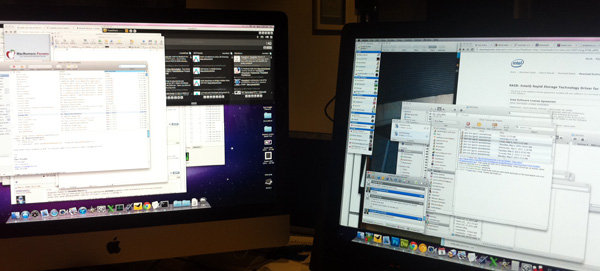
27-inch iMac (left) vs. 27-inch Cinema Display (right)
Obviously that's just a calibration issue, but it shows a little more foresight on Apple's part with the 27-inch iMac. Viewing angles seem the same between the two as well. There is a noticeable change in how Apple maps brightness levels to the software OSD on the iMac vs. the Cinema Display however. The iMac's controls are far more linear:
I'm not sure if Apple has made similar changes in currently shipping versions of the 27-inch Cinema Display but it makes a whole lot more sense now. Linear controls for non-linear curves are silly.
The change in default white point alone should be an indication that Apple is experimenting with panels or panel vendors, the rest of the data seems to back this up as well. Maximum brightness is down a bit and but so are black levels, which means overall contrast ratio remains unchanged.

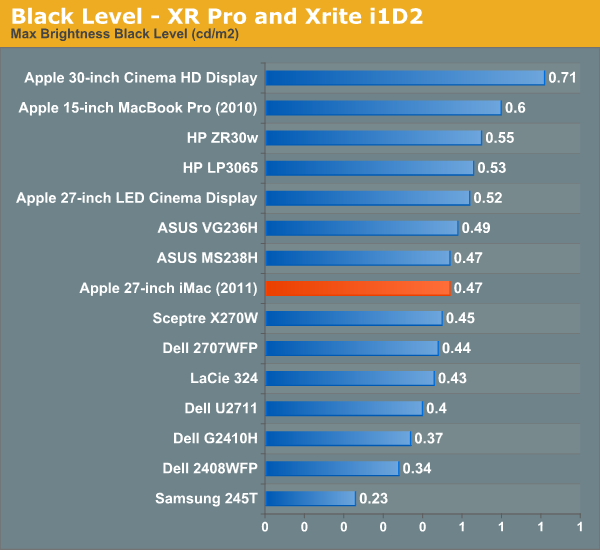
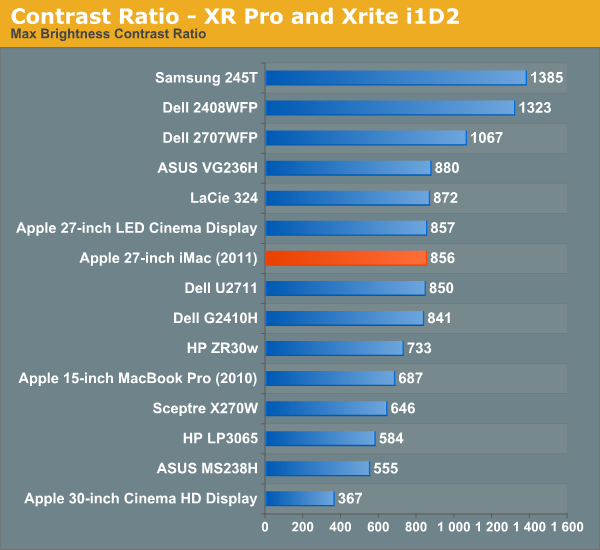
The new panel seems less uniform than the old one but it's not something that's noticeable in regular use, only if you actually measure the white/black levels on the panel.
Where the 2011 iMac does a lot better than my Cinema Display is in its color reproduction. The overall delta-E of the new panel is measurably lower than what was used in the first run of 27-inch Cinema Displays (and presumably last year's iMac):
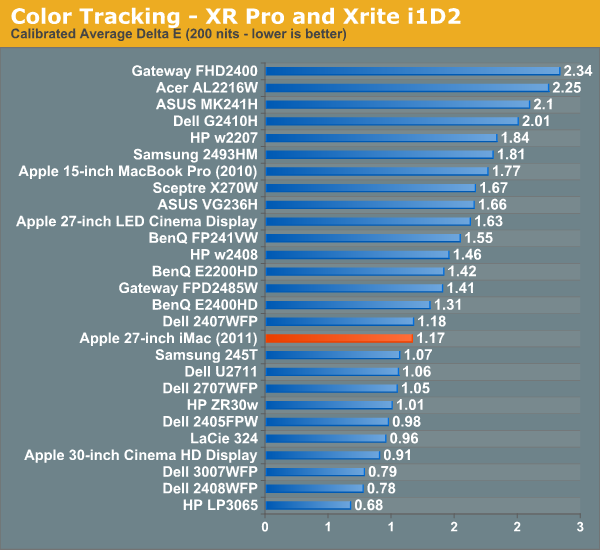
I will say that despite what you see here numerically, you'd be hard pressed to tell a difference between the two panels as long as they're both calibrated.
Color gamut is a bit worse on the new panel vs. the old one from what I can tell. Both are WLED backlit which limits the spectrum of colors they can accurately reproduce.
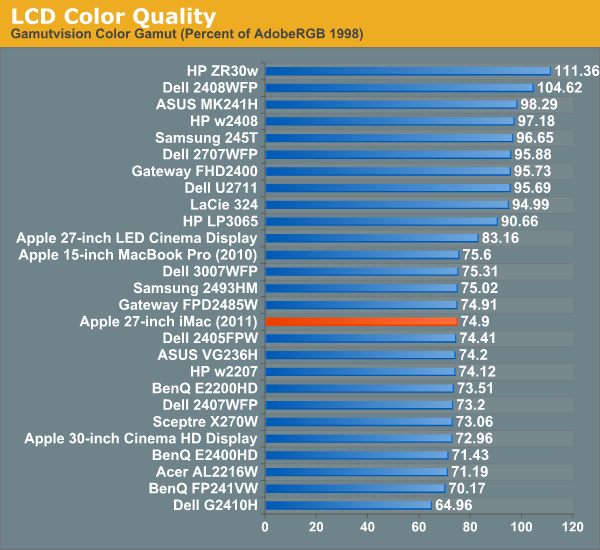
Overall I'm just as much a fan of the 27-inch iMac display as I was of the 27-inch Cinema Display. The iMac is obviously bulkier but overall desk footprint is similar and you get a Sandy Bridge system as a part of the deal.












139 Comments
View All Comments
iwod - Friday, May 27, 2011 - link
My problem is with Apple's Memory upgrade. They have 2x 2GB fitted which means if you want 8GB you either have to pay sily amount to apple, or buy 4GB x2 yourself and sell your original to someone else.As soon as the hardware encoder inside Intel can be accessed through Mac OSX, i believe 4 Core 8 thread will be enough for 99.9% of my task. Next year iMac GPU upgrade should be much more important then CPU IvyBridge.
And only if Apple actually make Z68 Intel SRT to work. We need SSD, in cache or main drive.
setzer - Friday, May 27, 2011 - link
Actually these iMacs have 4 so-dimm slots, so you should be able to get 8gb's fairly easily and cheap, though if I was changing the memory I would also change the hdd in one go, opening that can is hard work..FATCamaro - Friday, May 27, 2011 - link
Yeah I bought the 27" with the SSD upgrade and bought memory separately. SSD isn't that much more than retail and the imac is a pain to open. The memory is a bit of a ripoff though.Zandros - Friday, May 27, 2011 - link
Isn't the memory accessible through removing a single screw at the bottom of the iMac, though? No need to go in through the display just for that.archer75 - Friday, May 27, 2011 - link
Actually it's 3 screws ;)But there are 4 ram slots. I just bought 16gb from newegg and plugged it in. Cost less than what apple would charge for 8gb.
KoolAidMan1 - Friday, May 27, 2011 - link
Anand - First off, great review as always.The conclusions you reached regarding the iMac's performance "finally" getting to an acceptable point is something that I came to with the release of the mid-2007 24" iMacs. Prior to that I had a PowerMac workstation for Final Cut Studio. The Core 2 Duo used in the 2007 iMac convinced me that an all-in-one would finally be a suitable replacement instead of a Mac Pro, and it was. It cost me much less than a Mac Pro while still giving me good performance and it had a 24" IPS display built in, which at the time ran $1000 by itself from NEC or Apple.
The 27" iMac released in late 2009 was a similar deal: a powerful i7-860 machine combined with a $1000 27" IPS display. iMacs make upgrading simple too, you just pack the whole thing in the original box and ship it off. The only thing you have to mental your way past is letting go of the display, and that isn't hard for me based on the fact that the 27" display in the current iMac is spectacular. It was a more than worthwhile upgrade from my prior 24" iMac, and it didn't cost me too much given that I sold the old one for about 60% of what I paid.
The 27" iMac display also functions as the primary display for my gaming PC. Unlike the iMac, my PC has SLI video cards so it can tear through that 2560x1440 res with no problem. Unlike the iMac, my PC isn't for work, it is for play. :)
This brings about my main issue with the 2011 iMacs, and it isn't something that was addressed in this review. I'm talking about the new requirements for Target Display Mode (using the iMac as a monitor for an external source) now that the mini-DP port was replaced with a Thunderbolt port. The only sources that you can use on the new iMacs are those equipped with Thunderbolt ports. For the time being this limits you to 2011 Macs, that's it. No old Macs, and no PCs until next year at the soonest.
Coming from someone that uses an iMac as an external display every day, that is pretty disappointing. Perhaps an active adapter or something will come out, but for the time being it really limits that aspect of the new iMacs.
Thanks again!
KoolAidMan1 - Friday, May 27, 2011 - link
Sidetrack - I suggest testing Starcraft 2 with ultra textures and medium settings. My PC has plenty of juice to run with everything cranked, but unless you take a still frame and examine it, the difference in visual quality between medium and ultra settings is not noticeable. The difference in framerate is VERY noticeable though, which is why I run at medium settings with ultra textures. Nice and fast while still looking pretty.I'm very curious to see how the new iMacs would run with those settings. In my own experience you're looking at nearly a doubling in framerate, but that is also with an SLI setup that may not have the same performance delta as the single GPU in the iMac. I also saw a huge difference with my laptop, but I didn't examine the framerate as closely with it so I can't say for sure if it is "nearly double" in that case.
jonwd7 - Friday, May 27, 2011 - link
The price comparison chart on the first page is wrong. I haven't made it through your review far enough to tell, but either you did not receive the high-end iMac, and you're quoting the wrong price ($1999) for the stats you've listed, or you did receive the high-end iMac, the price is right, but the stats are wrong.The stats you have listed are for the $1699 model.
krazyderek - Friday, May 27, 2011 - link
i noticed this as well, specifically this means,the $1999 model currently features the 6970 1gb, and 3.1ghz quad core i5
the $1699 model currently features the 6770 512mb not the 5xxx
in fairness the $1499 model should really be used along with the $1199 to compare to those other price points.
The $1999 model is in a completely different class and should be compared to it's appropriate competitors
psonice - Friday, May 27, 2011 - link
I'd say this isn't really much of an issue. When most people upgrade, they sell their old box - and the mac holds its value incredibly well. So what actually happens is in a couple of years you sell the old box for a large chunk of cash, and spend a smaller-than-expected sum on the new one.Basically, macs are surprisingly cheap when you factor in the resale value. You either keep them long term (and they pay for themselves then anyway), or you sell after a few years and get half your money back. This is assuming it doesn't break down - if that happens, they're very expensive ;)
Example: My 2007 24" imac was ~£1200. Resale value for similar spec on ebay today: ~£650-700. That means it's cost me around £500-£550 over 4 years, roughly the cost of a low-end desktop with an OK screen.
Oh, and I did upgrade mine to SSD (I've ignored that when looking at the prices). Yeah, it's a "fun" upgrade, and I ditched the HDD completely so I missed out on the 'removing the motherboard' stuff. Suction cups aren't actually required - you can get by with a pair of car windscreen mounts for GPS.
An easier way to access the HDD would be very welcome - especially as the new ones come with a special SATA connector so you'd need to buy an apple-specific drive too! (Not sure if this was covered in the article, I skipped a lot of it, but it's a pretty major downside for us technical types - the average punter probably wouldn't care less).